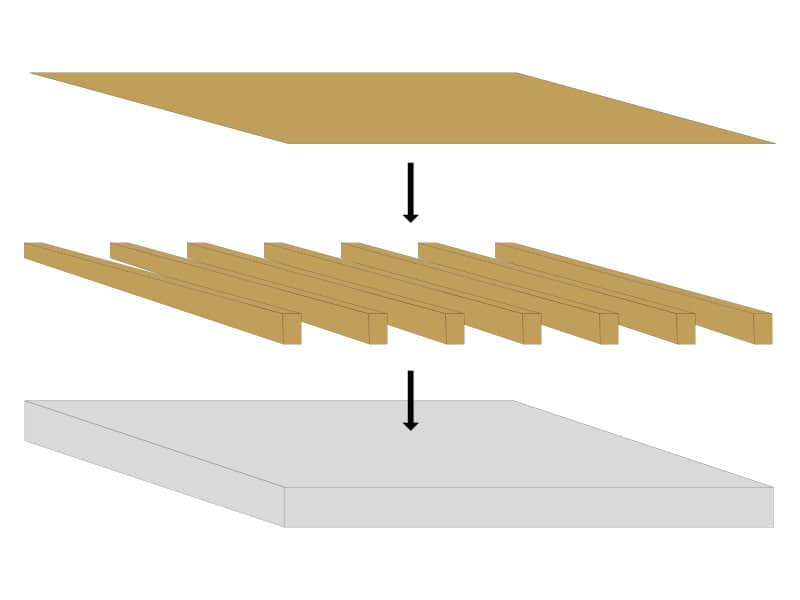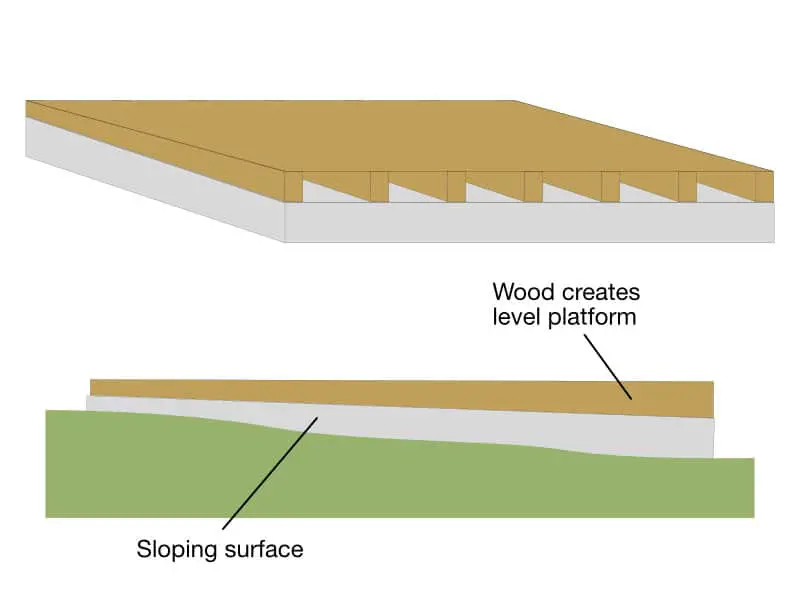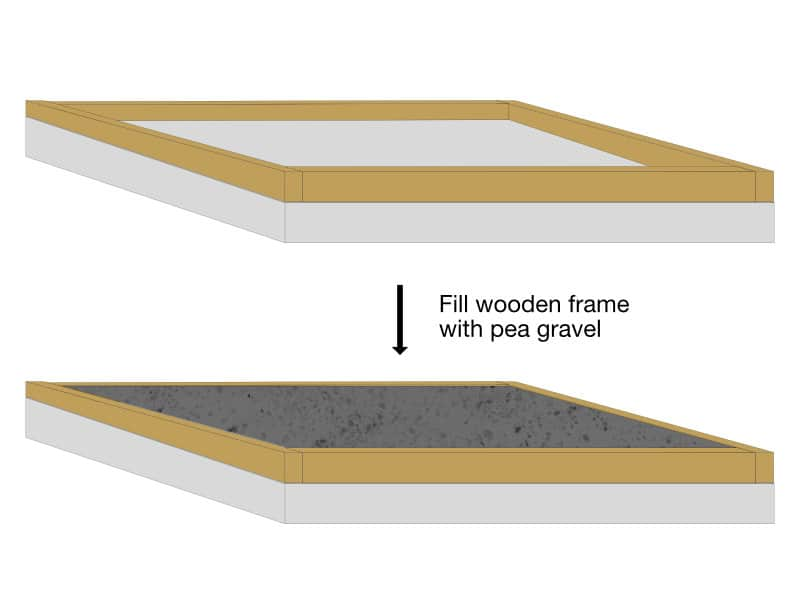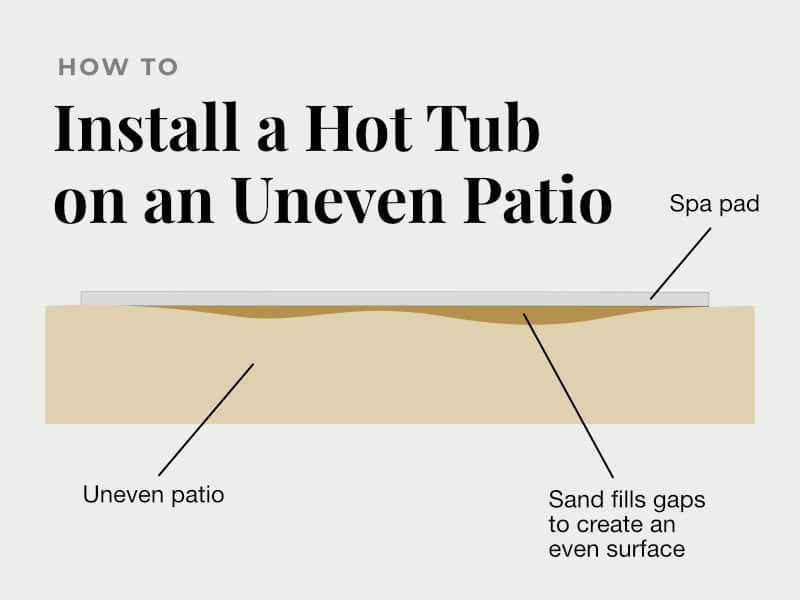How to Level (or Shim) a Hot Tub: 5 Simple & Cost-Effective Methods

By Jennifer Rhodes · Updated
As an Amazon Associate I earn from qualifying purchases.
If you own or are planning to get a hot tub, you know the common advice is to get the site as level as possible before installing the spa. A hot tub that is not level can cause damage to the tub—or even void the warranty.
But how much does this really matter? And how can you level a pad that already exists? Or even a spa that is already in place?
There are actually a few different ways you can level a hot tub. In this article, we will discuss five of the easiest options.
Why do spa pads need to be level?
Spa pads need to be level for a number of reasons:
- First, a sloped pad will cause the water to rest to one side of the tub, which is visually unappealing to a lot of people.
- Second, over time, a non-level spa can cause stress to the acrylic and cabinet which may eventually lead to cracking or leaks. If something happens down the road to the shell or cabinet, and it is found that the tub was not level, the manufacturer's warranty may no longer be valid.
- Finally, a sloping spa can be uncomfortable to use, as the water will not be evenly distributed around the tub. Some areas will be deeper than intended, so could also overflow when you have multiple bathers.
This is why it's always recommended to make sure that your spa pad is level before installing a hot tub.
Can you shim a hot tub?
In many cases, you can shim a spa that is already in place. The most common way to tell if your spa might need shimming is if the water level comes up higher on one side than the other.
If you notice this, the first step is to ask your dealer or manufacturer if they recommend or allow shimming for your particular model. If so, they will likely also have specific recommendations for how to do so.
In general, it is important to evenly support the bottom of the tub to prevent any twisting or sagging, which could damage the shell or plumbing over time. If done correctly, shimming can be a helpful way to level out your spa and ensure that it remains stable and functional for years to come.
Shimming a spa is a relatively simple process, and it can be done with a few tools and materials that are readily available at most hardware stores. There are several different techniques which we'll cover in a moment. Be sure to read through them all so you can choose the one that is best suited to your situation.
How to move a spa so the base can be leveled
Moving a spa can be a difficult and dangerous task. If not done properly, the tub can become damaged or cause injury. Here's the easiest method:
- First, jack the tub up enough to roll some pieces of PVC pipe underneath. This will allow you to roll the spa out of the way.
- Roll the spa 'uphill' or away from the downward direction of the slope.
- Build the new platform or level the area where the spa should sit.
- Finally, roll the tub back onto the new wedged platform. This should be easy if you are going from the top or 'skinny' side of the wedge.
By taking these precautions, you can ensure that your spa is moved safely and without incident.
5 ways to level a spa
1. Leave it and live with a small slope
If you only have a small slope to your spa area (an inch or two difference from one side of the spa to the other may be ok), the first option is to simply leave it as is and live with the slight incline. This is of course the easiest option, as it won't require any work on your part.
You generally don't need to be too worried about the slope of your hot tub as long as the water is able to cover the filter, and the height of the water into the filter compartment meets the manufacturer's recommendations.
It's also beneficial to put the filter on the "deep" side of the tub if you can. The most important thing is that all of the jets near the waterline are submerged so that they can work properly. As long as you keep these things in mind, you should be able to enjoy your hot tub without any issues.
If you find the visual difference too irritating, or the slope creates more than about 2 inches of difference, you may want to consider leveling it out.
2. Pour a leveling concrete cap over the area
If you're looking to level an existing concrete slab for your hot tub, there are a couple of different approach you can take.
One option is to pour a leveling concrete cap over the existing area. To do this, you'll need to use self-leveling concrete, which should bond to your concrete if you scarify the surface first.
Another option is to jackhammer out the existing pad and re-pour it. This may be a more labor-intensive approach, but it will provide a more solid foundation for your hot tub.
Whichever method you choose, be sure to follow all safety precautions and take your time to ensure a smooth, level surface.
3. Lay pavers
Pavers are a type of paving stone that can be used to create a variety of different surfaces, from walkways and patios to driveways, pool decks, and spa bases.
Pavers are available in a wide range of materials, including concrete, brick, stone, and tile. They come in a variety of shapes and sizes, and can be laid in a variety of patterns.
You can also use pavers or tiles to cover up an existing sloped patio to create a level spa base. Build up the low side with either mortar or crushed limestone first to create a level surface, then lay the pavers on top.
4. Build a wooden platform
Building a wooden platform for your spa is a relatively simple project that can be completed in a weekend. This is a good option for when you have a sloping surface that is already flat and even, like a concrete slab or smooth patio.
You will need pressure-treated 2x4s and a spirit level for this.
- The first step is to measure and cut the lumber to the size of the base of the spa.
- To determine the angle, place a piece of 2x4 on the slope, and then lift one end until it is level (place the level on top to tell).
- Measure the height of the gap at the end to the ground. That is where to start cutting the wedge on the end of each 2x4.
- Then cut the 2x4s into long wedges, spacing them about one foot apart underneath the full width of your spa. Treat the area you have cut with a wood preservative.
- Next, lay down 3/4" pressure-treated exterior grade plywood on top of the wedges, using short coated deck screws to secure it in place.

After the platform is built, it can be painted or stained to match the surrounding décor. It can also be left natural for a more rustic look.
This will create a durable base that will keep your spa level and prevent it from shifting over time.

5. Build a gravel pad
A gravel pad is a great way to create a level, stable foundation for your hot tub. It's also an inexpensive and easy-to-install option that can be done in a weekend.
To build a gravel pad, you'll first want to build a frame using 2x4 pressure-treated wood, ripped in the sloping direction on two sides. This is so that once you put it on the sloped surface, the top will be level.
To ensure the frame is the right size, make it at least 1" wider in each direction than the dimensions of the spa base.
Once you have the frame built, fill it with pea gravel and level it with a rake. The pea gravel will support the weight of the spa and prevent shifting, as well as provide great drainage. You can also lag bolt your frame to any existing concrete pad.

Building a gravel pad is a simple and effective way to create a level foundation for a hot tub. With a little bit of effort, you can have one of these installed in no time.
What if your spa pad is level but not flat?
If your spa pad is level but not flat or even (it has some dips, for example), it's important to fix the dips before setting up your hot tub. Dips in the pad can cause the hot tub to sit unevenly, which can put stress on the frame and lead to warping or leaks.
To fix dips in your spa pad, one option is to grind down any high spots until the area is a uniform height. This will help to create a more even surface.
If this is not an option (like if you have nice patio stones which you don't want to ruin), you can use a little sand to fill in the gaps and flatten the area. Once the area is flat, you can add foam board for exterior use or a pre-made spa pad like the EZ Pad or Handi-Pad for stability.

By taking these steps, you can ensure that your spa pad is level and flat, providing a stable foundation for your hot tub.
Closing thoughts
If your hot tub is not level, it can cause a number of problems. The most common is an unsightly slope to the water level, but it can sometimes lead to more serious issues like cracks, leaks or warping, and could even void your warranty.
But don't worry, there are a few things you can do to level a hot tub—even after it's installed. Most cases of a sloping spa can be solved by building a simple wooden frame from pressure treated 2x4, and optionally filled with pea gravel.
